Neurotech monthly. July 2023
In-ear neurotech and Apple, MEG+DBS, DBS+AI, data from a publicly-traded neurotech company, a brain surgery on a fetus
The July 2023 issue of astrocyte* newsletter is here. Among other things, it covers:
Neurotech reading list
- Hardware: in-ear bioelectronics from the future and Apple’s EEG-powered AirPods, 3D printing for microfluidics and ECoG, MEG+DBS, MEG for 2-meter movement, a single-photon camera for brain imaging;
- Data Science - a unified neural network for different EEG paradigms, AI applications for DBS;
- Misc reading - a brain surgery on a fetus, expectations and attitudes towards visual prostheses.
Startup/Corporate news
- EEG-powered sleep analytics startup and a public minimally-invasive neurotech company raise capital.
My interpretations/comments are marked as ‘Peter Zhegin’
📬📬📬 Subscribe for a monthly update on neurotech and neurotech investment/commercialisation activity.
Thanks!
Subscribe
I. Reading List
Techstack/Hardware
Peter Zhegin: In 2021 I flagged that Apple was ‘… studying the potential of AirPods as a health device. Earbuds could be offered as hearing aids and include an in-ear thermometer and posture warnings’.
Now it seems that Apple went further. Here is a good teardown of what Apple has patented:
The biosignals measured by AirPods could include, but are not limited to, an electroencephalography (EEG), electromyography (EMG), electrooculography (EOG) and more.
But the frontier has already moved. Researchers propose Conformal in-ear bioelectronics for visual and auditory brain-computer interfaces
Here, we develop in-ear bioelectronics … which can adaptively expand and spiral along the auditory meatus under electrothermal actuation, thus ensuring conformal contact while avoiding over-constrain on the meatus. As a result, EEG can be stably recorded with the proposed discreet and wearable bioelectronics without affecting the subjects’ communication with the outside world…
Here is a thread:
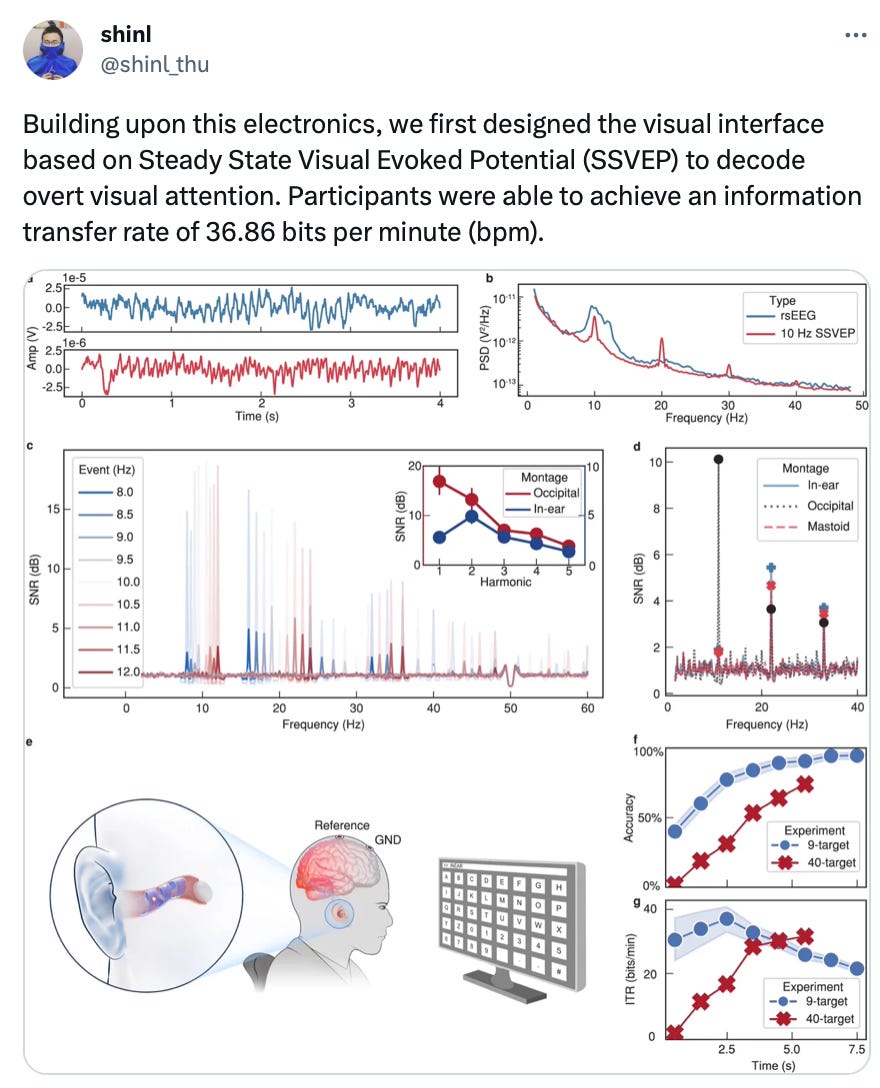
Deployable electrodes for minimally invasive craniosurgery
The first prototype consists of an electrode array that fits through a hole 2 cm in diameter, but when deployed, extends across a surface that’s 4 cm in diameter. It has 6 spiraled-shaped arms, to maximize the surface area of the electrode array, and thus the number of electrodes in contact with the cortex.
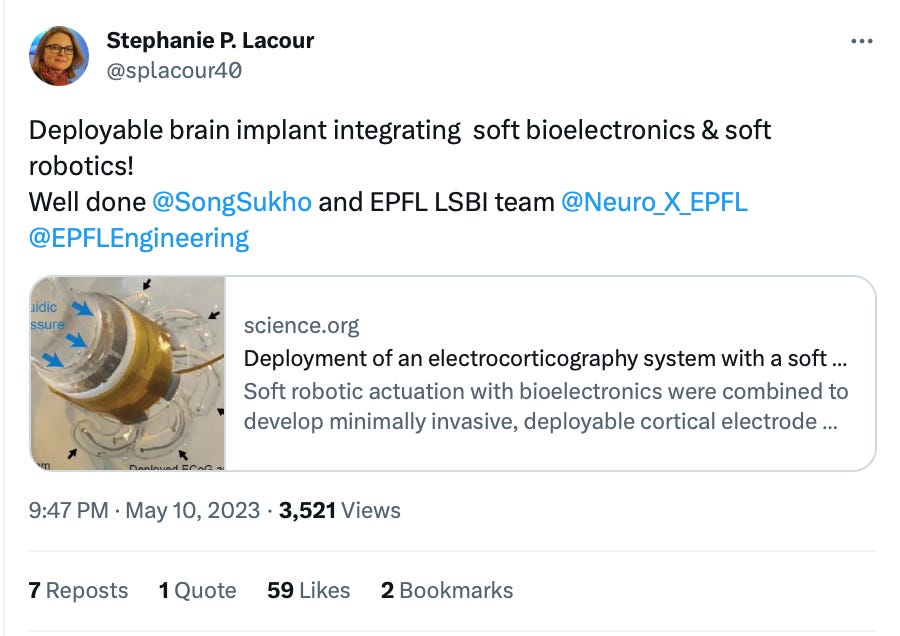
Implantable photonic neural probes with 3D-printed microfluidics and applications to uncaging
In recent years, a variety of implantable silicon (Si) neural probes have been developed with dense arrays of microelectrodes…Parallel efforts have developed neural probes with integrated microfluidic channels for fluid injection and sampling of extracellular fluids… In this work, we present a method of integrating microfluidic structures onto neural probes using additive two photon polymerization 3D printing.
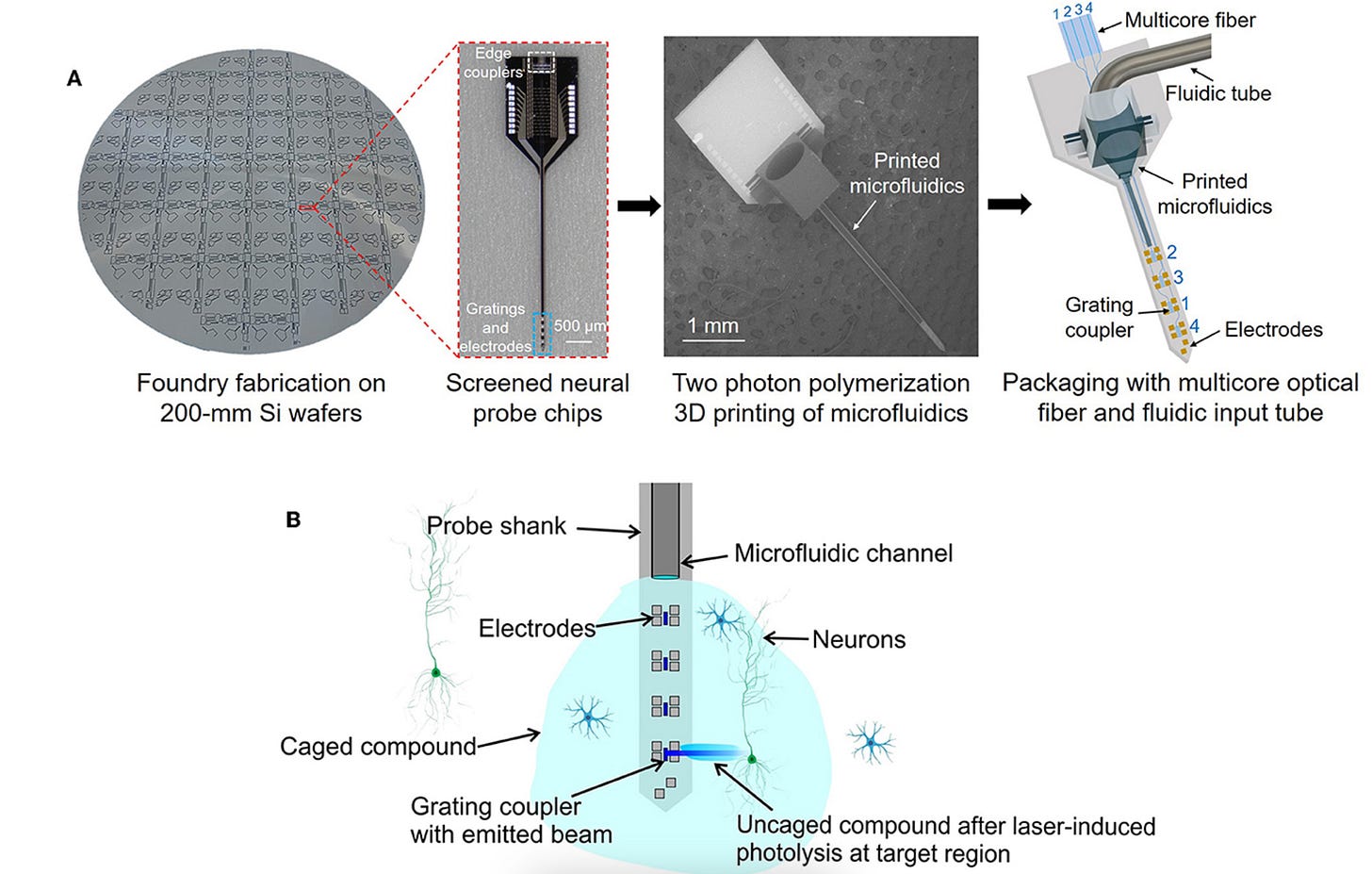
In this study, we developed a highly flexible 22-channel ECoG microelectrode array on a thin Parylene film using novel fabrication techniques. … Narrow (<40 µm) and thin (<500 nm) microelectrode patterns were first printed on PDMS, then the patterns were transferred onto Parylene films via vapor deposition and peeling. A custom-designed, 3D-printed connector was built and assembled with the Parylene-based flexible ECoG microelectrode array without soldering.
Our study provides direct evidence that the specific tACS procedures are capable of delivering electrical currents to deep brain tissues, opening a realistic avenue for modulating or treating neuropsychiatric disorders associated with hippocampus, insula, and amygdala.
Peter Zhegin: tACS, tFUS, TMS, and other non-invasive modalities are very exciting. There should be an opportunity for startups to build software/devices to help identify, develop proper protocols and optimise workflows.
Peter Zhegin: In June 2021’s newsletter, I covered MEG, and that was starting to have momentum. The key was ‘… the development of optically pumped magnetometers (OPMs)’.
Now a study of MEG and DBS compatibility finds that:
‘… the novel OPM MEG sensors are more resilient to monopolar stimulation artefact than conventional cryogenic sensors which might open new avenues for application of OPMs for studying DBS effects’.
Also:
‘… results confirm the feasibility of using Percept PC with SenSight leads for combined telemetric streaming and MEG recordings. Advanced offline artefact removal techniques are likely to further improve MEG data quality.’
Peter Zhegin: MEG continues to excite me, and I feel it is overlooked by the tech/startup community.
Here is more about this DBS + MEG study:
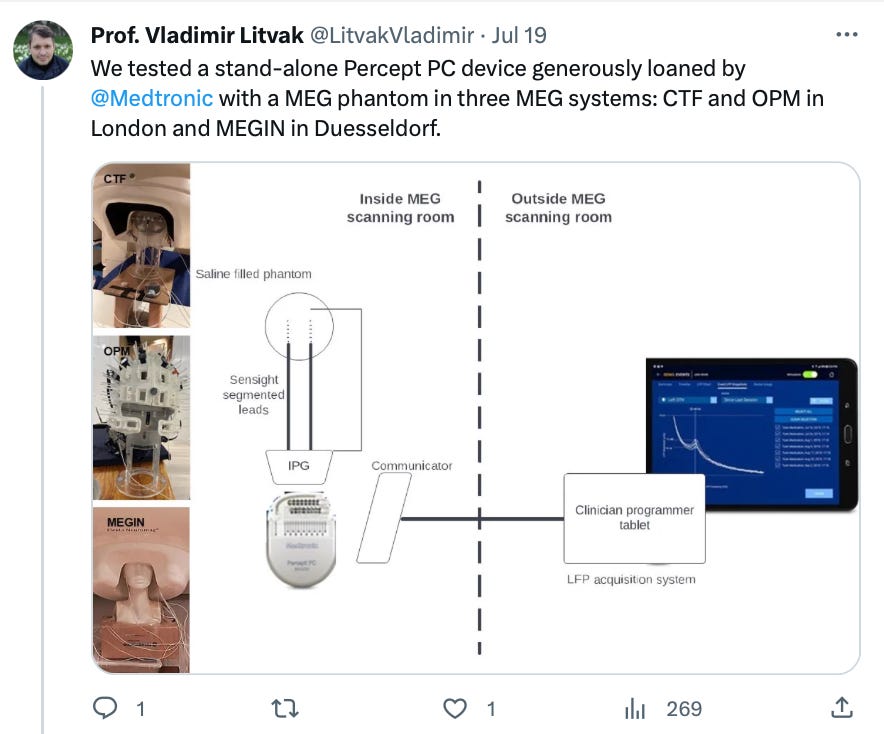
Peter Zhegin: OP-MEG’s advantage is its ability to be used on a moving participant (approximately 1 m movement). The challenge is that ‘… environmental magnetic fields vary both spatially and temporally and OPMs can only operate within a limited magnetic field range, which constrains participant movement’.
An attempt to increase the movement rage is made via Real-time, model-based magnetic field correction for moving, wearable MEG.
Here we implement real-time updates to electromagnetic coils mounted on-board of the OPMs, to cancel out the changing background magnetic fields. … We demonstrated that introducing this feedback to OP-MEG measurements during movements of up to 2 m reduced the changes in background field due to movement and so increased the number of analysable trials by keeping the OPMs within their dynamic range.
Peter Zhegin: An inspiration to me is using MCG (Magnetocardiography) without a shielded room. Even if the ‘… magnetic field produced by the human heart is more than 100 times greater in strength than the field generated by the brain’, I hope once shieldless MEG will be possible.
A very interesting pattern of improvement in superconductor cameras, going from 2K -pixel devices to 40K-pixel. At last, single-photon cameras could peer into your brain
Superconductor-based cameras that can detect a single photon… have existed for 20 years, but they’ve remained confined to laboratories due to the inability to scale them past a few pixels.
…The performance of a single pixel is stellar, but putting many of them close to one another on a single chip has been a long-standing challenge. To achieve superconductivity, the device has to be cooled to cryogenic temperatures, and wiring up many pixels into the cooling system is prohibitive.
… To overcome these difficulties, the team drew inspiration from other detector technologies. They borrowed the idea of a common read-out bus, collecting detector information from an entire row or column of pixels at a time. …The key was figuring out the asymmetric scheme in which the signal from a detector would be transferred to the bus, but not vice versa.
Peter Zhegin: the obvious application for diffuse correlation spectroscopy.
Here is a story of the invention, and here is the lead author
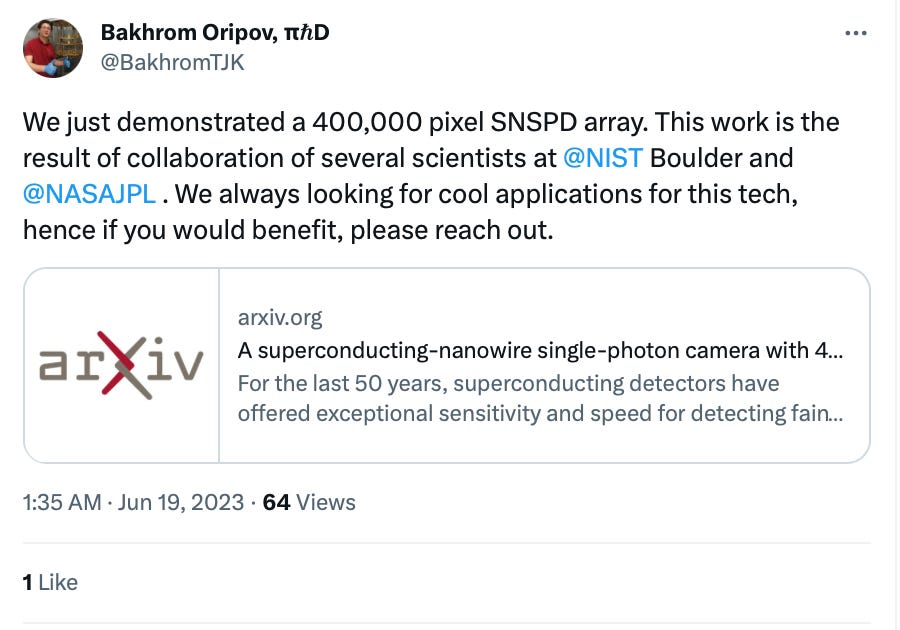
Data Science
… EEG is often acquired with different paradigms. … developing task- or paradigm-specific feature algorithms is labour-intensive. To address this challenge, researchers have explored the use of neural network technologies [incl. attentino-based]. … However, the application of existing attention mechanisms in EEG signals faces three key challenges due to the specific characteristics of EEG. To solve these issues, in this paper, we propose a unified Lightweight neural network model integrated with MultiDimensional Attention modules (LMDA-Net in the following context), for EEG recognition from different paradigms, different acquisition systems.
AI and deep brain stimulation: what have we learned?
Deep brain stimulation (DBS) has been used to treat patients with move-ment disorders… In recent years, the technique has been applied to various brain circuits in an attempt to treat mental health disorders. … although the outcomes are highly variable. …factors related to precise electrode position and electrical parameters — are potentially modifiable. … The two most explored areas for the use of AI are to facilitate target localization and to select electrical stimulation parameters.
Among the applications mentioned are: 1) QuickNAT and FastSurfer for segmenting larger cortical and subcortical structures but are less accurate for small DBS targets. U-Net, which is considered to be the current state-of-the-art segmentation architecture. 2) image enhancement or ‘quality transfer’ - using high-quality MRI datasets to train deep learning algorithms to crunch lower-quality MRI datasets. 3) denoising of diffusion MRI or resting-state functional MRI (fMRI) data; 4) stimulation settings based on clinical data.
Misc neurotech reading
Doctors have performed brain surgery on a fetus in one of the first operations of its kind
The baby’s condition, known as vein of Galen malformation … occurs when a vein connects with an artery in the brain. … Over time the vein essentially blows up like a balloon… The resulting balloon of blood can cause serious problems for a baby.
Doctors used ultrasound imaging to help them guide a needle through the mother’s abdomen, the uterus wall, and the fetus’s skull and into the malformation in the brain. Members of the team fed a tiny catheter through the needle to deliver a series of tiny platinum coils into the blood-filled pocket. Once each was released, it expanded, helping to block the point where the artery joined the vein. … Once they saw that it [blood flow in the brain] had returned to healthy levels, they stopped injecting coils and carefully removed the needle.
The baby girl was born healthy a couple of days later… She didn’t need any treatment for the malformation.
Attitudes of potential recipients toward emerging visual prosthesis technologies
In assessing the expectations and attitudes towards visual prostheses of blind individuals who were potential recipients of these vision-restoring devices, we found a largely negative landscape due primarily to the technological limitations of current devices. … We conclude that substantial advances are still required before broad acceptance of visual prostheses will be found.
II. Startup/Corporate News
🇺🇸NeuroOne raised $5.3M in post-IPO equity—a rare case of a revenue-generating public neurotech company. NeuroOne develops minimally invasive and hi-definition solutions for EEG recording, brain stimulation and ablation solutions. They generated $630K in product revenues in Q2 2023. More details in their 8-K and 10-K forms.
Peter Zhegin: I’d suggest founders look at these filings, which show how revenues build-up, on costs, etc.
🇰🇷Slowave raised a seed round. It offers sleep analysis via EEG technology.
📬📬📬 Subscribe for a monthly update on neurotech and neurotech investment/commercialisation activity.